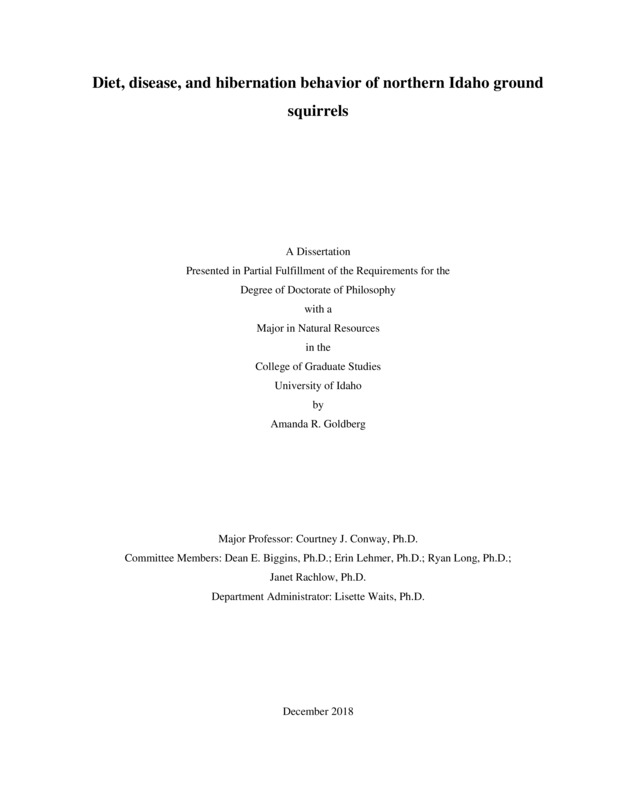Diet, disease, and hibernation behavior of northern Idaho ground squirrels
Goldberg, Amanda Renee. (2018-12). Diet, disease, and hibernation behavior of northern Idaho ground squirrels. Theses and Dissertations Collection, University of Idaho Library Digital Collections. https://www.lib.uidaho.edu/digital/etd/items/goldberg_idaho_0089e_11480.html
- Title:
- Diet, disease, and hibernation behavior of northern Idaho ground squirrels
- Author:
- Goldberg, Amanda Renee
- Date:
- 2018-12
- Keywords:
- dna metabarcoding fleas food selection hibernacula plague Urocitellus brunneus
- Program:
- Natural Resources
- Subject Category:
- Wildlife conservation
- Abstract:
-
Anthropogenic changes have caused wildlife extinctions across the world. Climate change, invasive species, habitat destruction, and human introductions of non-native diseases often have interactive effects and pose challenges to endemic wildlife populations. Understanding the processes that constrain population abundance is essential for effective management of rare species. The northern Idaho ground squirrel (Urocitellus brunneus) is a threatened species that persists in a relatively small number of isolated populations within 0.05% of their former range. The primary hypothesis for their decline is due to years of fire suppression that enabled conifer trees to encroach on the open spaces these squirrels occupy. However, this habitat loss hypothesis may not be the only cause for the species decline. We tested 3 alternative hypotheses that may also be suppressing population growth of this threatened ground squirrel: (1) sylvatic plague hypothesis, (2) nutrient limitation hypothesis, and (3) climate sensitivity hypothesis. The sylvatic plague hypothesis suggests that plague may be directly decreasing abundance of northern Idaho ground squirrels. To test this hypothesis, we combed and removed fleas from northern Idaho ground squirrels and 3 coexisting small mammal species (Urocitellus brunneus, Tamias amoenus, and Peromyscus maniculatus). We identified 7 species of fleas; all 7 species are known to be capable of transmitting plague and 3 of the 7 species were collected from all 4 small mammal species (i.e., 3 species of fleas can readily transmit plague across these 4 sympatric small mammal species). We also designed an experiment where we removed fleas from paired and un-paired sites to test an explicit prediction of the plague hypothesis: that animals without fleas will have less opportunity to get plague and therefore have higher survival than control animals. We found that survival was between 2% and 50% greater (depending on species and study design) for flea-removal animals compared to un-treated (control) animals for all 4 species of small mammals in both the paired and un-paired flea-removal studies. We found the same pattern (higher survival for animals in flea-removal treatments) for all 4 species in both experimental designs, suggesting that plague is present and negatively impacting survival of northern Idaho ground squirrels and coexisting small mammals. The nutrient limitation hypothesis is a more explicit, mechanistic version of the fire suppression hypothesis and suggests that shifts in plant community composition (from fire suppression) may be limiting certain key nutrients required by northern Idaho ground squirrels and the limited availability of these key nutrients has caused the past population declines in squirrels. Northern Idaho ground squirrels appear to be selective feeders (they consume some plants more often than they are found in their environment). In addition, survival was higher for squirrels consuming Perideridia sp. in the summer and lower for those consuming Frasera sp. The climate sensitivity hypothesis suggests that thermal conditions are no longer ideal for northern Idaho ground squirrel overwinter survival due to reductions in snow pack. We documented the habitat features that influence winter season (hibernacula) and summer season (active season) habitat selection in northern Idaho ground squirrels. We found that northern Idaho ground squirrels preferred hibernacula locations which had steeper slopes, higher canopy cover, and more trees than the areas that they used during the summer active season. Survival was greater for squirrels that hibernated near logs, and squirrels that hibernated in locations with more snow (duration and depth) emerged later in the spring (a behavior that likely improves survival). Overall, results from all 3 of these alternative hypotheses point to areas of concern for populations of northern Idaho ground squirrels. However, management solutions are possible to address these concerns and hopefully lead to population increases and eventual recovery of the species.
- Description:
- doctoral, Ph.D., Natural Resources -- University of Idaho - College of Graduate Studies, 2018-12
- Major Professor:
- Conway, Courtney J
- Committee:
- Rachlow, Janet L; Long, Ryan A; Biggins, Dean E; Lehmer, Erin M
- Defense Date:
- 2018-12
- Identifier:
- Goldberg_idaho_0089E_11480
- Type:
- Text
- Format Original:
- Format:
- application/pdf
- Rights:
- In Copyright - Educational Use Permitted. For more information, please contact University of Idaho Library Special Collections and Archives Department at libspec@uidaho.edu.
- Standardized Rights:
- http://rightsstatements.org/vocab/InC-EDU/1.0/

